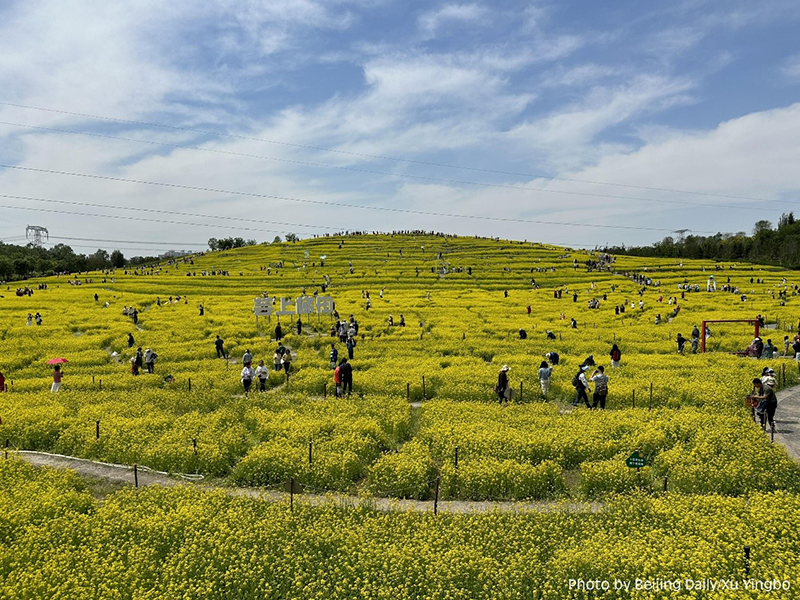



▲ The photo shows the rapeseed landscape in Wenyu River Park in Beijing. [Beijing Daily/Xu Yingbo]
5. Showcasing the Majestic Charm of the Capital.
5.1 Reinforcing the characteristic features.
(3) Inheriting cultural deposits.
Strengthen the integration of natural landscapes and historical culture, preserve cultural memories, and maintain a sense of place and nostalgia.
(4) Highlighting scenic mountains and rivers.
Protect the continuous and majestic contours of the Taihang Mountains to the west and the Yanshan Mountains to the north. Coordinate the relationship between the hill ridges and the urban skyline, and control the relationship between the hill footlines and urban development boundaries. In the built-up areas of the hill regions, optimize buildings that affect the ridgeline landscape through height control and roof form transformation.
Strengthen the construction control and landscape guidance around the five major rivers and reservoirs, focusing on promoting the Grand Canal, Liangma River, and Bahe River to create a scenic waterfront shoreline into urban spaces.
5.2 Constructing landscape view corridors.
Identify 25 landscape viewpoints and 49 landscape view corridors. Develop a four-season landscape corridor system to view urban patterns, natural scenery, historical sites, and landscapes. This will shape rich, layered landscape interfaces and accessible viewing locations, providing diverse urban viewing experiences for citizens.
5.3 Optimizing the Fifth Facade.
Create a clear, orderly spatial structure for the fifth facade. Enhance the overall quality of the fifth facade by appropriately increasing vertical greening and creating rooftop gardens, and focus on the management and optimization of the fifth facade in historic
5.4 Strengthening the colorization of the whole city.
Ensure the natural landscape colors match the primary color tones of the city and guide urban and plant colors by zones. Emphasize themes such as "spring's bright, summer's green, autumn's colorful, and winter's silvery" to strengthen plant color matching design, reinforce the sense of depth and layering, and shape identifiable and impactful landscape scenes.
6. Coordinating the Allocation of Diverse Elements.
6.1 Improving the green leisure system.
Develop diverse green spaces to improve people's sense of green access. Strengthen the connectivity function of greenways by integrating various linear spatial elements. Emphasize the main role of municipal greenways and promote greenway construction at different levels. Enhance the service efficiency of greenways to create vibrant green leisure and recreational circles.
6.2 Promoting the integration of production, living, and ecological spaces.
Enhance the integration of the “three parks and one district", key urban functional areas, and green ecological resources to create high-quality production and living spaces. Shape high-quality green open spaces and leisure facilities around urban commercial districts and important cultural venues to enhance the city's cultural charm. Strengthen the connection and integration of urban slow traffic networks, greenway networks, and waterfront slow traffic networks, and carry out unified planning and design of the three networks. Promote park sharing and expand open park spaces. Promote the opening and sharing of greening within land plots, and strengthen integrated space construction.
6.3 Enhancing health and livability.
Promote the construction of small green spaces, community gardens, and micro-gardens in hutongs (lanes). Advance the greening of 265 important roads in the central urban area with forest shade coverage. Implement the “one tree per yard” initiative in bungalow areas. Improve the aesthetic quality of indoor public spaces in public buildings, and advocate for the full opening of indoor public green spaces to the public. Enhance the ecological service capacity of urban green spaces, and increase the coverage rate of the 500-meter service radius of parks and green spaces in built-up areas. Strengthen the wellness functions of urban green spaces, reasonably match vegetation and landscape, focus on landscape aesthetic value, and improve the visual experience.
6.4 Stimulating multifunctional value.
Enrich the diversified service functions of green space and emphasize green construction requirements friendly to all age groups. Enhance the multi-layered utilization of green spaces by promoting vertical greening expansion, including rooftop greening, balcony greening, building facade greening, under-bridge space greening, pedestrian overpass greening, and sunken plaza greening. Foster the integration and interaction of public art with garden environments and optimize the arrangement of urban furniture.
6.5 Improving ecological service efficiency.
Advance the construction of natural belts and rewilding management, and build community natural habitat gardens that combine fine and wild to promote research on wild plants suitable for local climates. Establish a multi-dimensional biodiversity protection system to create more carbon sinks, optimize plant allocation, and build high-carbon sink plant communities.
6.6 Enhancing safety and resilience.
Improve the landscape design of protective facilities in planned flood storage and detention areas and important river embankments. Strengthen rainwater and flood management, promote the construction of rainwater-collecting parks and green spaces, advocate for permeable and water storing roads and squares, and encourage the development of green ecological residential communities. Enhance the compound utilization of green spaces to improve the level of "dual-use for peace and emergency."
7. Shaping Garden Scenes.
Develop eight types of garden scenes: garden residential areas, garden streets, garden public service facilities, garden business districts, garden offices, garden factories, garden villages, and garden stations. In conjunction with key initiatives such as urban renewal actions, the "demonstration of 100 villages and revitalization of 1000 villages project," backstreet and alley governance, and other key work, continually advance the pilot construction of various garden scenes, formulate technical guidelines for garden scenes and summarize the construction models and implementation paths for garden scenes.
Source:
<https://www.beijing.gov.cn/zhengce/zfwj/zfwj2016/szfwj/202404/W020240425644820814901.pdf>
<https://mp.weixin.qq.com/s/FYjubt4oVGI-0xW5O5oCSQ>